Obtaining Federal Aid is not as difficult as you might think. No matter who you are, you simply have to complete the FAFSA, also known as the Free Application for Federal Student Aid. (And yes, it’s free to apply.)
Why should you complete the FAFSA?
Completing this application form could be the most important thing you do when it comes to getting money to help pay for your education, and it may be the only form you need to fill out for some schools to determine your federal and state financial aid eligibility. In short, the FAFSA takes into account your or your family’s income, assets, and other information to calculate what you can afford to contribute to your education expenses. (Other information might include having siblings in college or family members on a fixed income.) This information is used to determine your eligibility for federal aid, as well as for many institutional, state, and private aid programs. This first-step financial aid application is used to determine eligibility for both undergraduate and graduate aid.
The following tips can help you maximize your chances of getting your share of financial aid.
The basics of the FAFSA application
- You can find the FAFSA online (www.fafsa.ed.gov), at high schools, at most libraries, or at a college financial aid office.
- The FAFSA lists a deadline of June 30, but some schools have what are called “priority processing deadlines” developed to encourage you to apply as early as possible in order to be eligible for all forms of aid they are able to award. Your best bet is to get the FAFSA in as soon as possible after January 1st each year.
- If you do not yet have completed tax forms, estimate your tax information to the best of your ability. You’ll be able to make corrections later.
- Even if you’re applying to 10 schools, you need only complete one FAFSA. (For aid at certain private schools, you may also have to submit the CSS Profile, which is due in late September or early October.) You can designate that up to 10 schools receive your FAFSA information automatically. They’ll use it to create your financial aid award notification.
Key ideas when completing the FAFSA form
- Always double check that your information is accurate. Fill out the form completely. A failure to do so could lead to a costly delay in processing.
- Be sure to submit all required forms along with your application. Also check if your school requires any additional paperwork.
- Meet every deadline, at the bare minimum. It’s an even better idea to beat the deadline by as much as possible. Remember, certain types of aid are offered on a first-come, first-served basis.
- Submitting your FAFSA financial aid application online is the fastest way to get results. To do so, you just need to request a PIN (Personal Identification Number) here. Filing online can help you catch errors right away.
- Provide accurate information, understand everything you’re signing, and comply with (or beat) all deadlines.
- Have questions? Many states have special call-in programs during January and February.
Your FAFSA helps you beyond the freshman year
- Your can find your renewal FAFSA online. You will be required to verify certain information that was carried over from the original FAFSA, make necessary changes, and supply any new information that is necessary.
- The renewal will be used to update your award if your financial information has changed in a way that impacts your eligibility.
What happens after you submit your FAFSA application?
Once you’ve submitted your FAFSA, it goes to the Central Processing System (CPS). The CPS uses the Federal Methodology to calculate your results and create your Student Aid Report (SAR). This is then sent to you, the financial aid office at the schools listed on your FAFSA, and your state’s aid office. Be certain to keep a copy for your records!
Regardless of the school, certain aid will be available to you as long as you qualify: Pell Grants, Direct Loans, and Federal Family Education Loans (for undergraduate students).
Other forms of aid are limited, including work-study awards, supplemental grants, and institutional aid. Each school uses the SAR to create your financial aid package. Some schools may include more grants in your aid package, which means you will have fewer loans to repay. Others may leave a gap between your costs and the amount of aid that is awarded to meet those costs. In those cases, you will have to bridge that gap (your “unmet need”) by alternate means. You’ll need to examine and compare each school’s financial aid award carefully to determine which is truly the best deal.



